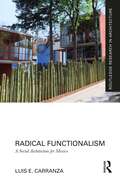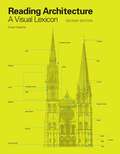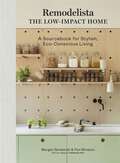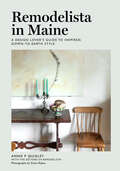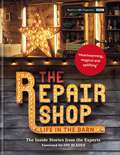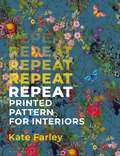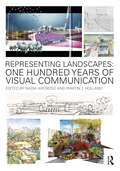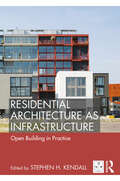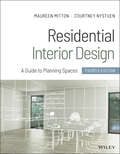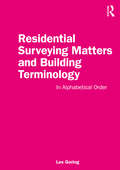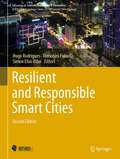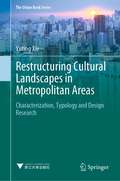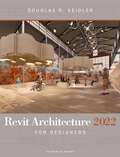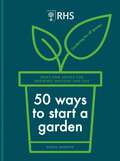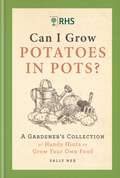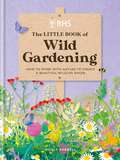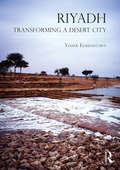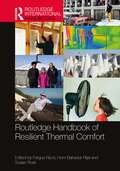- Table View
- List View
Radical Functionalism: A Social Architecture for Mexico (Routledge Research in Architecture)
by Luis E. CarranzaRadical Functionalism: A Social Architecture for Mexico provides a complex and nuanced understanding of the functionalist architecture developed in Mexico during the 1930s. It carefully re-reads the central texts and projects of its main advocates to show how their theories responded to the socially and culturally charged Mexican context. These, such as architects Juan Legarreta, Juan O’Gorman, the Union of Socialist Architects, and Manuel Amábilis, were part of broader explorations to develop a modern, national architecture intended to address the needs of the Mexican working classes. Through their refunctioning of functionalism, these radical thinkers showed how architecture could stand at the precipice of Mexico's impending modernization and respond to its impending changes. The book examines their engagement and negotiation with foreign influences, issues of gender and class, and the separation between art and architecture. Functionalist practices are presented as contradictory and experimental, as challenging the role of architecture in the transformation of society, and as intimately linked to art and local culture in the development of new forms of architecture for Mexico, including the "vernacularization" of functionalism itself. Uniquely including translations of two manifesto-like texts by O’Gorman expressing the polemical nature of their investigations, Radical Functionalism: A Social Architecture for Mexico will be a useful reference for scholars, researchers and students interested in the history of architectural movements.
Radical Functionalism: A Social Architecture for Mexico (Routledge Research in Architecture)
by Luis E. CarranzaRadical Functionalism: A Social Architecture for Mexico provides a complex and nuanced understanding of the functionalist architecture developed in Mexico during the 1930s. It carefully re-reads the central texts and projects of its main advocates to show how their theories responded to the socially and culturally charged Mexican context. These, such as architects Juan Legarreta, Juan O’Gorman, the Union of Socialist Architects, and Manuel Amábilis, were part of broader explorations to develop a modern, national architecture intended to address the needs of the Mexican working classes. Through their refunctioning of functionalism, these radical thinkers showed how architecture could stand at the precipice of Mexico's impending modernization and respond to its impending changes. The book examines their engagement and negotiation with foreign influences, issues of gender and class, and the separation between art and architecture. Functionalist practices are presented as contradictory and experimental, as challenging the role of architecture in the transformation of society, and as intimately linked to art and local culture in the development of new forms of architecture for Mexico, including the "vernacularization" of functionalism itself. Uniquely including translations of two manifesto-like texts by O’Gorman expressing the polemical nature of their investigations, Radical Functionalism: A Social Architecture for Mexico will be a useful reference for scholars, researchers and students interested in the history of architectural movements.
Reading Architecture Second Edition: A Visual Lexicon
by Owen HopkinsAnyone with an interest in buildings and the built environment would do well to purchase a copy of Owen Hopkins' book. - MonocleThis innovative and unique book is a visual guide to the buildings that surround us. Architectural features are pinpointed and labelled on images of buildings so that, unlike with other architectural dictionaries, you don't have to know the name before looking it up. Clear line drawings and extensive colour photographs illustrate each of the main building types, from forts to churches, stately homes to skyscrapers. The individual structural elements and materials common to all buildings are then explained, whether in Classical, Gothic or Modernist style. A comprehensive glossary completes the book. This revised edition includes an expanded section on modern structures and materials, as well as the latest styles and concepts from the last ten years. A must for all lovers of architecture and those who would like to learn moreOver 11,000 copies sold in English worldwide Covers all key building types and styles, from cathedrals to skyscrapers, Classical to contemporary. Each building type is illustrated with extensive photographs and annotated drawings Contains a comprehensive glossary of architectural terms
Remodelista: A Sourcebook for Stylish, Eco-Conscious Living (Remodelista)
by Margot Guralnick Fan Winston&“Easy ideas . . . . The kind of guidebook we reference again and again. . . with recommendations for every single room in the house.&” —Real Simple Learn how to make planet-friendly choices at home with the design experts of Remodelista.com Concerned about the state of the planet and wanting to do your part? Written with urgency, Remodelista: The Low-Impact Home gives clear guidance and inspiration for creating a home that&’s both sustainable and stylish. The book features room-by-room tips for reducing your environmental footprint, as well as tours of artful living quarters belonging to people who interpret low-impact living in a myriad of ways, from a remodeled apartment inspired by the Slow Food movement to a tree-house cabin to a multigenerational courtyard compound. Every page offers information that you can act on right away—including best practices for choosing household essentials, from lightbulbs to sofas; guidelines for a low-impact, energy-efficient remodel; and how to recycle or donate your castoffs so they don&’t end up in the landfill. Like all Remodelista books, this manual is both a visual delight and an invaluable resource. Change begins in the home, and it&’s inspiring to learn how climate-aware living choices, no matter how small, contribute to the greater good. Guidance includes: Low-impact remodeling ideas and approaches for every room Planet-friendly essentials: paint, rugs, bedding, furniture, and more The Vintage 75: favorite tried-and-true objects for everyday use Plus the lowdown on composting, energy-efficient appliances, insulation, HVAC, roofing, and more
Remodelista in Maine: A Design Lover's Guide to Inspired, Down-to-Earth Style (Remodelista)
by Annie QuigleyMaine by Design Celebrate the rugged, resourceful, eco-conscious Maine aesthetic and get a master class from Remodelista in translating this style into your own home. Tour ten exceptional, beautifully photographed houses, and discover the details that make a Maine house a Maine house—from floors painted in glossy boat paint to artful displays of nature-walk finds. Also included: simple, seasonal DIY projects, like fragrant balsam pillows; tips from local shopkeepers, chefs, and makers on living the Maine way; a collection of Remodelista&’s thirty favorite Maine objects for the house (and porch); and design-centric itineraries for travelers planning a visit any time of year.
The Repair Shop: LIFE IN THE BARN: The Inside Stories from the Experts: THE LATEST BOOK
by Elizabeth Wilhide Jayne Dowle'Heartwarming, magical and uplifting'In today's throwaway culture, there's a counter movement growing that urges us to 'make do and mend'. The BBC's BAFTA Award winning The Repair Shop has brought this waste-conscious message to an even wider audience, with its regular viewing figures of 7 million in the UK alone, cementing itself as a classic series in the vein of Antiques Roadshow.This new book concentrates on the show's much-loved experts, including woodworker and furniture restorer Will Kirk, clock restorer Steve Fletcher, metalworker Dominic Chinea, silversmith Brenton West, leatherworker Suzie Fletcher, upholsterer Sonnaz Nooranvary, and seamstresses Julie Tatchell & Amanda Middleditch - aka The Teddy Bear Ladies. Each of the experts shares their own stories and their repairs, capturing in the process the magic and ethos of the barn. Includes quotations and Q & As from the experts as well as Jay Blades on some unique restoration collaborations.With the focus on the experts themselves, readers will feel as though they're stepping straight into the 'workshop of dreams' and experiencing first hand the magic of the barn.
Repeat Printed Pattern for Interiors
by Kate FarleyRepeating patterns can soothe or energize us, bringing joy and harmony to everyday life. Repeat Printed Pattern for Interiors explores the power repeat patterns hold over us and what goes into creating original, effective printed designs. Beginning with the history of patterns in interior design, Kate Farley uncovers lessons from the work of Owen Jones, William Morris, Collier Campbell and Josef Frank.There are also interviews with some of the best contemporary pattern designers working today: Angie Lewin, Deborah Bowness, Eley Kishimoto, Emma J. Shipley, Galbraith & Paul, Neisha Crosland, Orla Kiely OBE, Sarah Campbell and Timorous Beasties. Each interview covers the designer's practice and ethos and includes a deconstruction of one design, with discussion of initial sketches, details of design development, manufacturing insights and images of final products.Covering hand-drawn techniques through to digital manipulation, you'll also be guided through the implications of visual language, colour statements, manufacturing considerations and commercial interior contexts to prepare you to jump in and start creating your own unique patterns.
Representing Landscapes: One Hundred Years of Visual Communication (Representing Landscapes)
by Nadia AmorosoThis volume provides an in-depth historical overview of graphic and visual communication styles, techniques, and outputs from key landscape architects over the past century. Representing Landscapes: One Hundred Years of Visual Communication offers a detailed account of how past and present landscape architects and practitioners have harnessed the power of visualization to frame and situate their designs within the larger cultural, social, ecological, and political milieux. The fifth book in the Representing Landscapes series, the presentations contained within each of the 25 chapters of this work are not merely drawings and illustrations but are rather graphic touchstones whose past and current influence shapes how landscape architects think and operate within the profession. This collected volume of essays gathers notable landscape historians, scholars, and designers to offer their insights on how the landscape has been presented and charts the development and use of new technologies and contemporary theory to reveal the conceptual power of the living medium of the larger landscape. Richly detailed with over 220 colour and black and white illustrations from some of the discipline’s best-known landscape architects and designers, this work is a ‘must-have’ for those studying contemporary landscape design or those fascinated by the profession’s history.
Representing Landscapes: One Hundred Years of Visual Communication (Representing Landscapes)
by Nadia Amoroso Martin HollandThis volume provides an in-depth historical overview of graphic and visual communication styles, techniques, and outputs from key landscape architects over the past century. Representing Landscapes: One Hundred Years of Visual Communication offers a detailed account of how past and present landscape architects and practitioners have harnessed the power of visualization to frame and situate their designs within the larger cultural, social, ecological, and political milieux. The fifth book in the Representing Landscapes series, the presentations contained within each of the 25 chapters of this work are not merely drawings and illustrations but are rather graphic touchstones whose past and current influence shapes how landscape architects think and operate within the profession. This collected volume of essays gathers notable landscape historians, scholars, and designers to offer their insights on how the landscape has been presented and charts the development and use of new technologies and contemporary theory to reveal the conceptual power of the living medium of the larger landscape. Richly detailed with over 220 colour and black and white illustrations from some of the discipline’s best-known landscape architects and designers, this work is a ‘must-have’ for those studying contemporary landscape design or those fascinated by the profession’s history.
Residential Architecture as Infrastructure: Open Building in Practice (Open Building)
by Stephen H. KendallThis edited collection provides an up-to-date account, by a group of well-informed and globally positioned authors, of recently implemented projects, public policies and business activities in Open Building around the world. Countless residential Open Building projects have been built in a number of countries, some without knowledge of the original theory and methods. These projects differ in architectural style, building industry methods, economic system and social aims. National building standards and guidelines have been promulgated in several countries (Finland, China, Japan, Korea), providing incentives and guidance to Open Building implementation. Businesses in several countries have begun to deliver advanced FIT-OUT systems both for new construction and for retrofitting existing buildings, demonstrating the economic advantages of ‘the responsive, independent dwelling.’ This book also argues that the ‘open building’ approach is essential for the reactivation of the existing building stock for long-term value, because in the end it costs less. The book discusses these developments in residential architecture from the perspective of an infrastructure model of built environment. This model enables decision-makers to manage risk and uncertainty, while avoiding a number of problems often associated with large, fast-moving projects, such as separation and distribution of design tasks (and responsibility) and the ensuing boundary frictions. Residential Architecture as Infrastructure adds to the Routledge Open Building Series, and will appeal to architects, urban designers, researchers and policy-makers interested in this international review of current projects, policies and business activities focused on Open Building implementation.
Residential Architecture as Infrastructure: Open Building in Practice (Open Building)
by Stephen H. KendallThis edited collection provides an up-to-date account, by a group of well-informed and globally positioned authors, of recently implemented projects, public policies and business activities in Open Building around the world. Countless residential Open Building projects have been built in a number of countries, some without knowledge of the original theory and methods. These projects differ in architectural style, building industry methods, economic system and social aims. National building standards and guidelines have been promulgated in several countries (Finland, China, Japan, Korea), providing incentives and guidance to Open Building implementation. Businesses in several countries have begun to deliver advanced FIT-OUT systems both for new construction and for retrofitting existing buildings, demonstrating the economic advantages of ‘the responsive, independent dwelling.’ This book also argues that the ‘open building’ approach is essential for the reactivation of the existing building stock for long-term value, because in the end it costs less. The book discusses these developments in residential architecture from the perspective of an infrastructure model of built environment. This model enables decision-makers to manage risk and uncertainty, while avoiding a number of problems often associated with large, fast-moving projects, such as separation and distribution of design tasks (and responsibility) and the ensuing boundary frictions. Residential Architecture as Infrastructure adds to the Routledge Open Building Series, and will appeal to architects, urban designers, researchers and policy-makers interested in this international review of current projects, policies and business activities focused on Open Building implementation.
Residential Interior Design: A Guide to Planning Spaces
by Maureen Mitton Courtney NystuenDiscover a practical guide to residential space planning, in this room-by-room guide with up-to-date info on accessibility, ergonomics, and building systems In the newly revised Fourth Edition of Residential Interior Design: A Guide to Planning Spaces, an accomplished team of design professionals delivers the gold standard in practical, human-centered residential interior design. Authors Maureen Mitton and Courtney Nystuen explore every critical component of interior architecture from the perspective of ergonomics and daily use. The text functions as a guide for interior design students and early-career professionals seeking a handbook for the design of livable, functional, and beautiful spaces. It includes hundreds of drawings and photographs that illustrate key concepts in interior design, as well as room-by-room coverage of applicable building codes and sustainability standards. The authors also cover all-new applications of smart building technology and updated residential building codes and accessibility standards. The book also includes: A thorough introduction to the design of interior residential spaces, including discussions of accessibility, universal design, visibility, sustainability, ergonomics, and organizational flow In-depth examinations of kitchens, bathrooms, and the fundamentals of residential building construction and structure Comprehensive explorations of entrances and circulation spaces, including foyer and entry areas, vertical movement, and electrical and mechanical considerations Practical discussions of bedrooms, leisure spaces, utility, and workspaces An overview of human behavior and culture related to housing Updates made to reflect changes in the 2021 International Residential Code (IRC) The latest edition of Residential Interior Design: A Guide to Planning Spaces is ideal for instructors and students in interior design programs that include interior design, residential design, or residential interior architecture courses. This edition provides updated content related to CIDA standards in human centered design, regulations and guidelines, global context, construction, environmental systems, and human wellbeing. It’s also an indispensable resource for anyone preparing for the NCIDQ, the interior design qualification exam.
Residential Interior Design: A Guide to Planning Spaces
by Maureen Mitton Courtney NystuenDiscover a practical guide to residential space planning, in this room-by-room guide with up-to-date info on accessibility, ergonomics, and building systems In the newly revised Fourth Edition of Residential Interior Design: A Guide to Planning Spaces, an accomplished team of design professionals delivers the gold standard in practical, human-centered residential interior design. Authors Maureen Mitton and Courtney Nystuen explore every critical component of interior architecture from the perspective of ergonomics and daily use. The text functions as a guide for interior design students and early-career professionals seeking a handbook for the design of livable, functional, and beautiful spaces. It includes hundreds of drawings and photographs that illustrate key concepts in interior design, as well as room-by-room coverage of applicable building codes and sustainability standards. The authors also cover all-new applications of smart building technology and updated residential building codes and accessibility standards. The book also includes: A thorough introduction to the design of interior residential spaces, including discussions of accessibility, universal design, visibility, sustainability, ergonomics, and organizational flow In-depth examinations of kitchens, bathrooms, and the fundamentals of residential building construction and structure Comprehensive explorations of entrances and circulation spaces, including foyer and entry areas, vertical movement, and electrical and mechanical considerations Practical discussions of bedrooms, leisure spaces, utility, and workspaces An overview of human behavior and culture related to housing Updates made to reflect changes in the 2021 International Residential Code (IRC) The latest edition of Residential Interior Design: A Guide to Planning Spaces is ideal for instructors and students in interior design programs that include interior design, residential design, or residential interior architecture courses. This edition provides updated content related to CIDA standards in human centered design, regulations and guidelines, global context, construction, environmental systems, and human wellbeing. It’s also an indispensable resource for anyone preparing for the NCIDQ, the interior design qualification exam.
Residential Surveying Matters and Building Terminology: In Alphabetical Order
by Les GoringThis is an ideal reference book for students (undergraduates and postgraduates) studying Building Surveying, Quantity Surveying, or Architecture, etc. It should also be of use to the Construction-related legal profession, Property Managers and Letting Agents. Builders (and homeowners, interested in identifying faults in their property), should also benefit from this book. Residential Surveying Matters and Building Terminology covers a wide range of new and old building terms, techniques, technologies and materials, but much more extensively than the average dictionary. The alphabetical format makes it easy to check up on terms and subject-areas quickly – and the detailed coverage (including helpful drawings by the author) provides clear guidance to the reader. This book covers a multitude of subject-areas, including condensation problems, cellar rot, wet rot and dry rot, thermal cracks, settlement cracks, metal wall-tie corrosion-and-expansion cracks, subsidence cracks, roof-spread recognition, bulging- and/or leaning-walls, etc. Further subject areas include inspecting and analysing residential building-structures, both internally and externally; appraising underground drainage systems; and personal commentary on survey report writing.
Residential Surveying Matters and Building Terminology: In Alphabetical Order
by Les GoringThis is an ideal reference book for students (undergraduates and postgraduates) studying Building Surveying, Quantity Surveying, or Architecture, etc. It should also be of use to the Construction-related legal profession, Property Managers and Letting Agents. Builders (and homeowners, interested in identifying faults in their property), should also benefit from this book. Residential Surveying Matters and Building Terminology covers a wide range of new and old building terms, techniques, technologies and materials, but much more extensively than the average dictionary. The alphabetical format makes it easy to check up on terms and subject-areas quickly – and the detailed coverage (including helpful drawings by the author) provides clear guidance to the reader. This book covers a multitude of subject-areas, including condensation problems, cellar rot, wet rot and dry rot, thermal cracks, settlement cracks, metal wall-tie corrosion-and-expansion cracks, subsidence cracks, roof-spread recognition, bulging- and/or leaning-walls, etc. Further subject areas include inspecting and analysing residential building-structures, both internally and externally; appraising underground drainage systems; and personal commentary on survey report writing.
Resilient and Responsible Smart Cities (Advances in Science, Technology & Innovation)
by Hugo Rodrigues Tomohiro Fukuda Simon Elias BibriThis book gathers current research studies which explore new technologies in architecture and urban practices which ensure the efficient management of cities’ infrastructures and provide new solutions to the complex complications that may result in the tackling of challenges of population density, traffic planning, and city planning at the neighborhood scale or rather the scale of buildings and everyday life. It offers a path towards city resilience and sustainable infrastructure with the aim of meeting the demands of mega-cities. The primary audience of this book will be academics and professionals from the fields of architecture, urban planning, civil engineering, computer sciences, and mathematics. The book will aid them in their contributions to the implementation of sustainable development goals.
Restructuring Cultural Landscapes in Metropolitan Areas: Characterization, Typology and Design Research (The Urban Book Series)
by Yuting XieThis book introduces a ten-year-long design research project in the Yangtze River Delta (YRD), China, based on international cooperation studios, design workshops, a Ph.D. thesis, and concrete practice in China, Germany, and the Netherlands. This research adapts the existing methods of Landscape Character Assessment (UK), Historic Cultural Landscape Elements (Germany), and Dutch Polder Typology to mapping, describing, and classifying landscape character areas and types at the three scales of regional, municipal, and local. Furthermore, to connect research with design, we developed a typological approach of generating specific measures for the networked polder landscape. This research bridges the gap of a missing landscape characterization method for the conservation, transformation, and critical reconstruction of historic cultural landscapes in a metropolitan context. The book is intended for graduate students, researchers, and practitioners interested in the topics of cultural landscape in transition, methods for landscape characterization and typology, and a research-by-design approach in interdisciplinary projects of landscape architecture, urbanism, and regional planning.
Revit Architecture 2022 for Designers
by Douglas R. SeidlerRevit® is rapidly replacing AutoCAD as the digital drawing tool of choice for architects and interior designers. This book aims to help design students master Revit® as a tool in the design studio and in practice.Revit® Architecture 2022 for Designers provides both a thorough primer for new learners and expanded conceptual discussion for design professionals. The progressive introduction of concepts (chapters build on previous chapters), digital exercises, and professional examples make this book easy to follow for learners new to Revit®. Packed with visual examples, it is written specifically for architecture and interior design students. NEW TO THIS EDITION· Instruction graphics updated for Revit® Architecture 2022 features and user interface· New instruction for drawing with metric units· New instruction on importing PDFs (Chapter 2), Photorealistic Rendering (Chapter 7), and Advanced Modeling (Chapter 10)
RHS 50 Ways to Start a Garden: Ideas and Inspiration for Growing Indoors and Out
by Simon Akeroyd***Aimed at first-time gardeners, those in rented accommodation or anyone with limited outdoor space, this book teaches how to take stock of an environment and start a garden. With ideas for gardens, patio spaces, courtyards, balconies and interiors, these 50 easy-to-adopt ideas provide the steps to success for even the most inexperienced gardeners. Contents include: - Create a floral display with bulbs that last all year - Grow pet-friendly plants- Create a vegetable harvest in pots - Add height in flat spaces- Make a mow-free lawn - Hang plants around your home
RHS Can I Grow Potatoes in Pots: A Gardener's Collection of Handy Hints for Incredible Edibles
by Sally Nex***This easy Q&A format book is suited to both beginner and more experienced growers, and encompasses a wide range of subjects to take readers beyond the basics of fruit and vegetable growing. Taking into account the popularity for growing food from scratch among newbie gardeners, you'll find advice in this book whether you have a garden, an allotment, or even a balcony or other small space to work with-everyone can get involved with growing delicious edibles no matter what space they have available. Discover: - Which varieties to choose for gourmet home cooking, the most nutritious crops to grow, and how to grow unusual edibles like olives. - Techniques and tips to get the most out of each crop, from how to grow epic-size pumpkins to whether it's worth thinning beetroot. - Troubleshooting tips for pest problems: ways to work with wildlife rather than against it and providing an alternative viewpoint on traditional problems, such as eating the weeds as well! - How to make the most of your fruit and vegetable harvest, with information on the best time to pick produce and how to preserve it.
RHS The Little Book of Wild Gardening: How to work with nature to create a beautiful wildlife haven
by Holly FarrellThe Little Book of Wild Gardening is a guide for anyone wanting to garden in a more sustainable, natural way. Working with nature benefits not just the garden, but also the gardener, wildlife and the wider environment. Divided into sections for different garden areas - including lawns, flower beds, edibles, trees and water features - The Little Book of Wild Gardening details how to embrace a natural approach to gardening for plots large and small.Introductory chapters explain how garden ecosystems can work, and how a healthy garden can mean savings in both work and resources for the gardener. There are plant profiles providing a variety of choices for a wilder approach, plus design tips and expertise in sustainable and wildlife-friendly gardening. From a sustainable veg patch to wildflower meadows, and from bat boxes to gravel gardens, the book includes projects and plants in a range of sizes and timescales so gardeners can create a bountiful and enjoyable haven that will benefit themselves, their local area, and all kinds of wildlife.
Riyadh: Transforming a Desert City (Planning, History and Environment Series)
by Yasser ElsheshtawyRiyadh has set its sights on becoming a world city befitting the twenty-first century. To that end it has embarked on a massive construction drive evidenced in the proliferation of proposals for high-end districts, giga-developments and elaborate infrastructures. An urban vision seemingly dedicated to attracting global capital. Yet such a narrative can be misleading. A ‘humanization programme’, initiated during the tenure of its former mayor Abdulaziz bin Ayyaf, has complemented the city’s rapid rise by providing spaces catering for the everyday needs of its inhabitants. Yasser Elsheshtawy, in this richly illustrated book, targets these people-centred settings. It is a compelling counter-narrative interweaving critical theoretical insights, personal observations, and serendipitous encounters. He deftly demonstrates how Riyadh thrives through the actions of its people. As the world moves towards an urban model that is resilient and humane, the humanizing efforts of an Arab city are worthy of our attention. Riyadh’s premise is perhaps best captured in the cover image depicting the desert riverbed of Wadi Sulai, filled with rainwater, making its way towards the Saudi capital. Along its banks there will be dedicated public pathways and urban parks. It is a vision of an urbanity where both the spectacular and the everyday coexist. A city that is not just dedicated to the few, but one that serves the many.
Riyadh: Transforming a Desert City (Planning, History and Environment Series)
by Yasser ElsheshtawyRiyadh has set its sights on becoming a world city befitting the twenty-first century. To that end it has embarked on a massive construction drive evidenced in the proliferation of proposals for high-end districts, giga-developments and elaborate infrastructures. An urban vision seemingly dedicated to attracting global capital. Yet such a narrative can be misleading. A ‘humanization programme’, initiated during the tenure of its former mayor Abdulaziz bin Ayyaf, has complemented the city’s rapid rise by providing spaces catering for the everyday needs of its inhabitants. Yasser Elsheshtawy, in this richly illustrated book, targets these people-centred settings. It is a compelling counter-narrative interweaving critical theoretical insights, personal observations, and serendipitous encounters. He deftly demonstrates how Riyadh thrives through the actions of its people. As the world moves towards an urban model that is resilient and humane, the humanizing efforts of an Arab city are worthy of our attention. Riyadh’s premise is perhaps best captured in the cover image depicting the desert riverbed of Wadi Sulai, filled with rainwater, making its way towards the Saudi capital. Along its banks there will be dedicated public pathways and urban parks. It is a vision of an urbanity where both the spectacular and the everyday coexist. A city that is not just dedicated to the few, but one that serves the many.
Routledge Handbook of Resilient Thermal Comfort (Routledge International Handbooks)
by Fergus NicolThis book brings together some of the finest academics in the field to address important questions around the way in which people experience their physical environments, including temperature, light, air-quality, acoustics and so forth. It is of importance not only to the comfort people feel indoors, but also the success of any building as an environment for its stated purpose. The way in which comfort is produced and perceived has a profound effect on the energy use of a building and its resilience to the increasing dangers posed by extreme weather events, and power outages caused by climate change. Research on thermal comfort is particularly important not only for the health and well-being of occupants but because energy used for temperature control is responsible for a large part of the total energy budget of the built environment. In recent years there has been an increasing focus on the vulnerabilities of the thermal comfort system; how and why are buildings failing to provide safe and agreeable thermal environments at an affordable price? Achieving comfort in buildings is a complex subject that involves physics, behaviour, physiology, energy conservation, climate change, and of course architecture and urban design. Bringing together the related disciplines in one volume lays strong, multi-disciplinary foundations for new research and design directions for resilient 21st century architecture. This book heralds workable solutions and emerging directions for key fields in building the resilience of households, organisations and populations in a heating world.
Routledge Handbook of Resilient Thermal Comfort (Routledge International Handbooks)
by Fergus Nicol Hom Bahadur Rijal Susan RoafThis book brings together some of the finest academics in the field to address important questions around the way in which people experience their physical environments, including temperature, light, air-quality, acoustics and so forth. It is of importance not only to the comfort people feel indoors, but also the success of any building as an environment for its stated purpose. The way in which comfort is produced and perceived has a profound effect on the energy use of a building and its resilience to the increasing dangers posed by extreme weather events, and power outages caused by climate change. Research on thermal comfort is particularly important not only for the health and well-being of occupants but because energy used for temperature control is responsible for a large part of the total energy budget of the built environment. In recent years there has been an increasing focus on the vulnerabilities of the thermal comfort system; how and why are buildings failing to provide safe and agreeable thermal environments at an affordable price? Achieving comfort in buildings is a complex subject that involves physics, behaviour, physiology, energy conservation, climate change, and of course architecture and urban design. Bringing together the related disciplines in one volume lays strong, multi-disciplinary foundations for new research and design directions for resilient 21st century architecture. This book heralds workable solutions and emerging directions for key fields in building the resilience of households, organisations and populations in a heating world.
